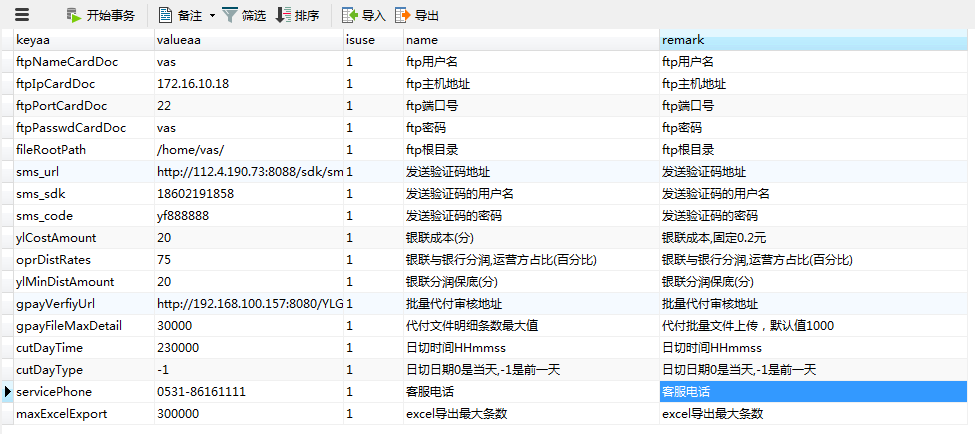Java缓存类的实际应用场景
不要着迷于技术,应把注意力放到问题上。
一个普通的后台管理系统,一定会有参数配置。参数配置数据表和其他的数据表是不同的,它的操作基本都是查的操作。参数配置的这些数据信息是贯穿在整个项目中,那么把他们放到哪里可以方便类或者jsp的调用?
spring的配置文件有支持缓存类,它的配置如下:
<!-- 启用用户的缓存功能 --> <bean id="userCache" class="org.springframework.security.core.userdetails.cache.EhCacheBasedUserCache"> <property name="cache" ref="userEhCache" /> </bean> <bean id="userEhCache" class="org.springframework.cache.ehcache.EhCacheFactoryBean"> <property name="cacheName" value="userCache" /> <property name="cacheManager" ref="ehcacheManager" /> </bean> <bean id="cacheManager" class="org.springframework.cache.ehcache.EhCacheCacheManager" p:cache-manager-ref="ehcacheManager"/> <bean id="ehcacheManager" class="org.springframework.cache.ehcache.EhCacheManagerFactoryBean" p:config-location="classpath:config/ehcache.xml"/>
然后在我们自己的缓存类中加入相应的注解即可:
package cn.wangze.service; import java.util.HashMap; import java.util.List; import java.util.Map; import org.springframework.beans.factory.annotation.Autowired; import org.springframework.cache.annotation.CacheEvict; import org.springframework.cache.annotation.Cacheable; import org.springframework.stereotype.Service; import cn.wangze.domain.SysMenu; import cn.wangze.domain.SysParam; import cn.wangze.utils.AuthUtils; @Service public class SysCacheService{ //具体需要缓存的数据视自己业务而定 /** * 项目中菜单的数据很少变动,所以我们把菜单数据也放到缓存里面 * */ @Autowired private SysMenuService<SysMenu> sysMenuService; /** * 注入系统参数的service * */ @Autowired private SysParamService<SysParam> SysParamService; /** * 创建Map对象保存系统参数的数据,方便调用 */ private Map<String,String> sysParamMap; /** * 通过调用这个方法可以取到缓存的菜单数据 */ @Cacheable(value="sysCache",key="methodName") public List<SysMenu> queryMenuList(){ List <SysMenu> list = sysMenuService.queryList(); if(list == null || list.size() == 0) return null; AuthUtils.clear(); for(int i=0;i<list.size();i++){ SysMenu m = list.get(i); AuthUtils.addAuth(m.getId(), m.getUrl()); } return list; } /** * 清除缓存中的某些数据,如果参数type为querySysParamList则全部清空 * */ @CacheEvict(value="sysCache",key="#p0") public void removeCatch(String type){ if(type.equals("querySysParamList")){ this.sysParamMap = null; } } /** * 清除缓存中的全部数据 * */ @CacheEvict(value="sysCache",allEntries=true) public void removeAll(){ this.sysParamMap = null; } /** * 查看缓存中全部数据 * */ @Cacheable(value="sysCache",key="methodName") public List<SysParam> querySysParamList(){ return SysParamService.queryList(null); } /** * 输入保存的key值,拿到对应的value。这个方法会经常用到。 * */ public String getSysParam(String key){ if(this.sysParamMap == null){ this.sysParamMap = new HashMap<String,String>(); for(SysParam param: querySysParamList()){ sysParamMap.put(param.getKey(), param.getValue()); } } return this.sysParamMap.get(key); } }
我们的缓存类SysCacheService就算写好了。可以看到第一次我们调用queryMenuList或者getSysParam方法时,如果map为空会从数据库中拿,如果map内部有数据存在,会直接从map拿数据。数据是以键值对的形式保存的。当我们想调用里面的数据时,只需要在操作类中注入SysCacheService,然后调用对应的方法。
举个例子,我的数据结构是这样的:

这是我的项目中的参数配置表,因为以前是oracle数据库,后来我把数据导入到mysql数据库里面时发现字段命名为"key"和"value"的话,查询sql语句会报错,所以换成了"keyaa"和"valueaa"。
MyController类想用一下系统配置的sms_url的值:
public String getSmsUrl(){ String sms_url =sysCacheService.getParam("sms_url"); return sms_url ; }
在MyController类中注入SysCacheService对象sysCacheService,并调用它的方法,传入参数"sms_url"就ok了。
后来,我想了想有没有更好的办法,把缓存放到一个类似工具类的静态类里面呢,这样就不用每次用到缓存数据都得注入一个SysCacheService了。方法如下:
1.在配置文件中添加一个servlet上下文的监听器,当servlet加载时,把SysCacheService放到静态类里面
2.在静态类中声明方法,代理SysCacheService的方法调用
xml配置文件增加一个listener:
<!-- 监听器,用于将缓存SysCacheService类封装成静态类 --> <listener> <listener-class> cn.wangze.listener.MyContextListener </listener-class> </listener>
MyContextListener代码如下:
package cn.wangze.listener; import javax.servlet.ServletContext; import javax.servlet.ServletContextEvent; import javax.servlet.ServletContextListener; import org.springframework.web.context.support.WebApplicationContextUtils; import cn.wangze.Constants; import cn.wangze.service.SysCacheService; public class MyContextListener implements ServletContextListener{ @Override public void contextDestroyed(ServletContextEvent arg0) { } @Override public void contextInitialized(ServletContextEvent sce) { ServletContext sc = sce.getServletContext(); SysCacheService sysCacheService = WebApplicationContextUtils.getWebApplicationContext(sc).getBean(SysCacheService.class); Constants.setSysCacheService(sysCacheService); } }
静态类的代码如下:
package cn.wangze; import cn.wangze.service.SysCacheService; public class Constants { private static SysCacheService sysCacheService; public static SysCacheService getSysCacheService(){ return sysCacheService; } public static void setSysCacheService(SysCacheService sysCacheService){ Constants.sysCacheService = sysCacheService; } public static String getParam(String key){ return sysCacheService.getSysParam(key); } }
这样,我们每次用到缓存数据时候,只需要引入Constants静态类,并直接用类名+方法名调用数据就行了。




 浙公网安备 33010602011771号
浙公网安备 33010602011771号